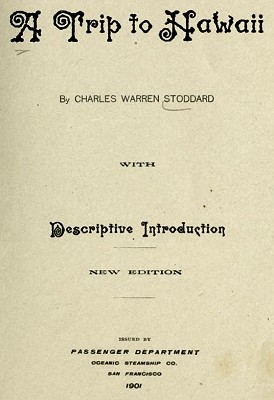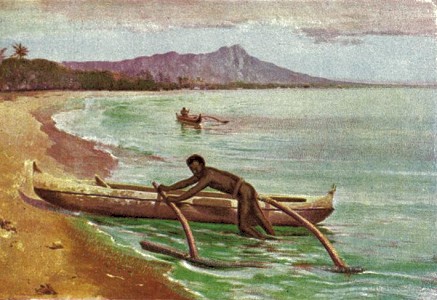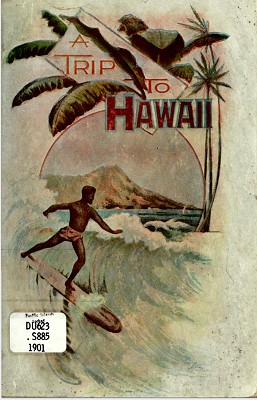 |
surfresearch.com.au
charles warren stoddard : a trip to hawaii, 1901 |
| home | catalogue | history | references | appendix |
|
openlibrary.org
http://openlibrary.org/books/OL25126558M/A_trip_to_Hawaii
A new edition, slightly
smaller at 46 pages, was issued in 1892 with an early photographic
plate which depicting surf riding (?).
The book was reprinted
in 1897, and a further edition published in 1901.
With the1897 and
1901 publications there was a change to the cover and added illustrations,
some of which were coloured.
These later editions
featured a coloured illustration of a surfboard rider framed by Diamond
Head on the cover.
The 1901 edition
also included a black and white photograph of a Hawai'ian native
holding a surfboard and wearing a malo (loincloth) on Waikiki Beach.
Tim DeLaVega accredits
the photograph to Frank Davey, one of several known to be taken of Charles
Kauha with his surfboard at Waikiki in April 1898, although none of him
surf riding.
The photograph also
appeared on a postcard published by the Island Curio Store, Honolulu, around
this time.
The photographs
and illustrations are not accredited.
- DeLaVega: Surfing in Hawai'i (2011), page 32.
In the introductory
notes there is a brief mention of surfriding, in the original text Stoddard
only refers to sea bathing.
There are some revelant
descriptive passages of the island geography.
The fifth edition notes that some of Stoddard's original text has been adjusted following the fall of the Hawaiian Republic in 1897and annexation by the United States.
Also see:
1874 Charles
Stoddard : Surfriding in Maui,
1867.
Biography
Charles Stoddard
(1843-1909) visited Hawaii between 1864 and 1867.
In 1869, he had
his first Polynesian story published in The Overland Monthly, which
lead to a collection published in America as South Sea
Idyls (1873)
and in the England as Summer Cruising in the South Seas (1874).
He returned to Hawai'i
in 1885.
In the late 20th
century, Summer Cruising in the South Seas was noted for its
homoerotic themes, fully discussed in Roger Austin's introduction to the
1987 edition.
| Frontpiece #2
Right: Title page [cropped] |
 |
INTRODUCTORY.
Many things have
happened in the little island country of Hawaii, set far out in the wide
Pacific, since 1885, the year when Charles
Warren Stoddard
visited it and wrote " A Trip to Hawaii," still the best known and most
admired book on these isles of the
Blessed.
His tender and
sympathetic insight into the tropic people and all their concerns, his
keen
enjoyment and appreciation of all the varied phases of the delightful journey,
his artist's eye to see and artist's hand to picture forth the beautiful
aspects of nature where nature is most prodigal of her charms, all unite
to make his writings on Hawaii dear to every one that loves the beautiful
in nature and in literary art.
Page VI
So it becomes
necessary to issue a fifth edition of this little volume and to alter the
introduction to Stoddard's graceful chapters, so that it shall take note
of these changes and testify to all the world that the charm of Hawaii
is in itself, and not in its form of
government, that
no revolution or political change can take away from the inherent enjoyableness
of a trip to the land of afternoons, and to show how by increase of facilities
it is now easier than ever before to visit all the many places of interest
and delight in beautiful Hawaii Nei.
Page VII
But all too soon
the excitement rises as to which of the passengers shall first convince
himself that the sailors are right in saying
that the tiny
cloud on the far horizon is really land.
At last the most
skeptical are conquered and gradually the blue cloud unrolls itself into
a fair green island, and soon the ship has
made her way
through the reef and lies in the placid harbor, at a wharf covered with
an interested and interesting crowd.
This crowd is
far more cosmopolitan than it was a few years ago.
Then the dark-eyed
Kanakas were in great majority, and now, though there are more of them
than of any one nationality, they are not much more numerous than the Japanese,
the Chinese, or the Portuguese.
The Americans,
however, are the predominant race, the people who own property, run businesses,
and occupy all places of responsibility.
Page VIII
On one side is
the blue water over which he has lately come, with its white fringe of
restless breakers; nearer, the quiet harbor
with ships of
several nations.
On the other
side is the Pali and the famous Punch Bowl, pretty good mountains, their
rugged sides covered far up with the luxuriant tropical foliage, and close
about him are the shaded streets of Honolulu, the pretty houses peeping
out from the palms and tree ferns, the banana and lantana trees.
Page IX
To see all the
Government buildings and trace the historic localities connected with the
various revolutions will take at least
two days ; for
it is not a climate that stimulates to undue activity.
Then there is
the Bishop Museum to see, a fine stone building filled to overflowing with
the most extensive collection in the
world of South
Sea and Hawaiian antiquities and curios.
Many important
articles that had been taken away from the Islands were sought out and
brought back to make every department of this fine collection complete.
Here may be studied
the curious ancient customs and religious observances of the Kanakas and
other island peoples, their strange gods, their primitive but formidable
clubs and war spears, their curious garments made of feathers, and all
the objects that bring back this ancient life.
In the yard is
the famous statue of Kamehameha the Great, looking the famous warrior he
is said to have been.
Then there is
the drive to Waikiki Beach, the watering place annex to Honolulu.
This will perhaps
be your first chance to see the famous swimming of the Kanakas, men and
women.
They sport in
the outer line of breakers, coming in over them on their surf boards in
a way that looks charmingly easy until you see some enthusiastic and over-bold
foreigner try it, and get rolled over and over, to his great discomfiture.
They will serve
you dinner in one of the beautiful flower-covered lanais, and you will
sit there till the brilliant white moonlight, and the blazing, low-hanging
stars give the night a witching glory.
This will be
enhanced by the sweet singing of native minstrels, whose liquid melodies
voice the very spirit of the place.
Page X
Drives to the
Pali and the Punch-Bowl will give excitement enough for two days.
The Pali is that
historic mountain and precipice overlooking Honolulu where Kamehameha the
Great is said to have overcome the last of his foes, and to have driven
them in great numbers over the dizzy brink.
No warlike tale
is needed, however, to give the trip interest.
The beauties
of the tropical flora on the earlier parts of the drive and the gradually
opening view as the road begins to wind up the steeper ascent are reward
enough.
When at last
the voyager leans against the slender railing that marks the very verge
and looks over the great expanse of the blue ocean, the quiet city that
lies at his feet, the beautiful sweep of the beach, curving out to where
Diamond Head like a silhouette of a sleeping form marks the horizon in
one direction, and all the expanse of emerald hills and smiling valleys
before him, he will surely declare the sight worth coming half way round
the globe to see.
Page XI
Of course, our
voyager by this time has on a pair of the most approved style of " sea
legs," and is not troubled by the somewhat
choppy seas of
the island channels.
Thus he can enjoy
to the full the pleasure of coasting about the fertile shores of Oahu,
and touching occasionally at the most seemingly impossible landings and
swinging off passengers and freight into lighters as the great swell lifts
the boats together.
It takes a brave
soul to attempt these landings, though use has robbed them of their terrors
for the dwellers in these ports.
Page XV
But it is high time to cease this introduction and let Mr. Stoddard's voice be heard on the subject that has brought forth his very best work.
Page 16
Page 20
On the morning
of the seventh day, an island rises like a small blue cloud out of the
sea; then another, and yet another, and
toward the last,
we make our way.
Green with a
verdure that never fades; brown with the bronze tints of lava-flows that
have been cold for centuries; a beach of dazzling whiteness, fringed with
groves of cocoa palms; the sea like a huge emerald, with sunshine reflected
upon the coral bottom, and brilliantly tinted fish sporting about us;
it is thus that we approach Honolulu at noon on the seventh day.
Looking at Diamond
Head from the sea, the volcanic shore promises nothing of the beauty that
is harbored in the vernal vales
beyond it; but
the moment our good ship rounds the point of the famous head-land, the
fairy-like coast line is suddenly revealed.
It is a transformation
scene.
The mountains
turn gloriously green.
Valleys, vistas
in Eden, dawn upon the eye in quick succession.
The sea rises
in long voluptuous waves and fawns upon the reef, while within the surf
the tranquil water is like a tideless river, where only the water-lilies
are lacking; but in their stead, are troops of Hawaiian swimmers veritable
water nymphs with a profusion of glossy locks floating about their shoulders
like seaweed.
Page 21
By this time the sea is littered with cocoanuts, but they are curly headed, most of them, and clamorous, for the dime-divers of Hawaii doff their garments at the shortest notice and disport themselves amphibiously so long as there is a prospect of raising another nickel out of the vasty deep.
Canoes dart upon
the water as if they were living things, part fish, part flesh, part fowl,
with one skeleton wing for an outrigger,
a fin paddle,
and a bare, brown Kanaka amidships.
Fish baptize
themselves by immersion in space, and keep leaping into the air like momentary
inches of chain lightning; there is the perpetual boom of the surf, the
clang of joy-bells on shore, and a possible shower in the refreshing cloud
that is stealing down from the heights.
"Three cheers
and a tiger," for the voyage has come to an end.
Page 26
But what should
we do to be saved from shameless indolence ?
First ride or
drive to the beach and bathe in a sea that rolls up warm from the Equator.
We can go en
masse in the 'bus,* or we can foot it if we are touched with the pedestrian
craze, for three miles even in this climate are not too many for an appetizer.
One may plunge for hours in the reef-girdled lagoon at Waikiki ...
Footnote: * The primitive 'bus is now supplanted by a street railroad.
Page 27
... without fear
of taking a chill; there are bathing suits there, and canoes, and a long
easy swell on which to undulate ; and there is
the Park to ride
or drive in, and the beautiful highways and the more beautiful byways between
the Park and the Town, where
every sense is
gratified at the self-same moment.
...and life at the beach really begins.
It begins with
a sunset across a tropic sea, and a twilight that seems longer than common
in this vicinity; sometimes there are
shadowy ships
in this twilight, and there are always canoes enough afloat to make one
wish to quote the easy lines about "autumnal leaves" and "brooks in Valombrosa.
"
Page 39
Hilo is a cluster
of summer houses hidden among palms and bread-fruit trees, where the rain
is said to fall perpetually ; perhaps it is for this reason that Hilo is
the most tropical in appearance, as it is certainly the most beautiful
of Hawaiian
hamlets.
What a shore it
has !
A crescent with
a row of houses facing it, where the tenants seem to have little else to
do than

 |
A Trip to Hawaii New ed. With descriptive introduction Published by Passenger Dept., Oceanic Steamship Co., San Francisco, 1901. openlibrary.org
|

| home | catalogue | history | references | appendix |